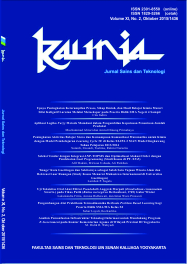UJI TOKSISITAS ORAL AKUT FILTRAT PSEUDOBULB ANGGREK MERPATI (DENDROBIUM CRUMENATUM SWARTZ.) PADA TIKUS PUTIH (RATTUS NORVEGICUS BERKENHOUT, 1769) GALUR WISTAR
DOI:
https://doi.org/10.14421/kaunia.969Keywords:
Pigeon Orchid, Dendrobium, toxicity, hematology, blood chemistryAbstract
Orchid species Dendrobium nobile Lindl. is commonly consumed by Chinese people as a natural drug that can cure various diseases. Pseudobulb is a part of the plant used for this purpose. Dendrobium crumenatum Swatrz. or Pigeon Orchid is epiphytic wild orchid, which widely found in Indonesia. As belong to the same genus, D. crumenatum could have similar potency to D. nobile. This research was carried out to study acute oral toxicity of Pigeon Orchid pseudobulb filtrate in Wistar Rats (Rattusnorvegicus Berkenhout, 1769) as initial assay prior to explore its potential as medicinal plant. Procedure followed OECD Test Guideline 425, which refers to animal welfare. Parameters observed including mortality, sublethal conditions, daily behavior, appetite, body weight, hematology test, and blood chemistry test. Results showed that no mortality was found as well as sublethal conditions that affected on health. Behavior investigation demonstrated that all individual exhibited normal activity. Furthermore, appetite increased, indicated by daily intake, which resulted in increasing body weight. Hematology test determined that no negative effects on the profile of erythrocytes, leukocytes, and platelets. Blood chemistry test stated that levels of glucose, total cholesterol, HDL, and LDL were within normal range. Levels of ALT and creatinine were also normal, indicating that liver and kidney functions were not impaired. In conclusion, Pigeon Orchid pseudobulb filtrate can be categorized as practically nontoxic. Based on this finding, exploration on Pigeon Orchid as a natural drug material can be conducted.
Downloads
Published
How to Cite
Issue
Section
License
All articles published in Kaunia are licensed under a Creative Commons Attribution-NonCommercial-ShareAlike 4.0 International license, with the copyright to these articles held by the journal. Anyone is free to read, download, copy, distribute, print, search, link to full text articles, or transform an article, in any medium or format, provided they do so non-commercially, give appropriate credit to Kaunia, and distribute any derivative work under the same (or equivalent) terms.
By submitting to Kaunia, authors agree to both the terms of the CC BY-NC-SA license and the automatic transfer of the copyright to their article if it is accepted.









